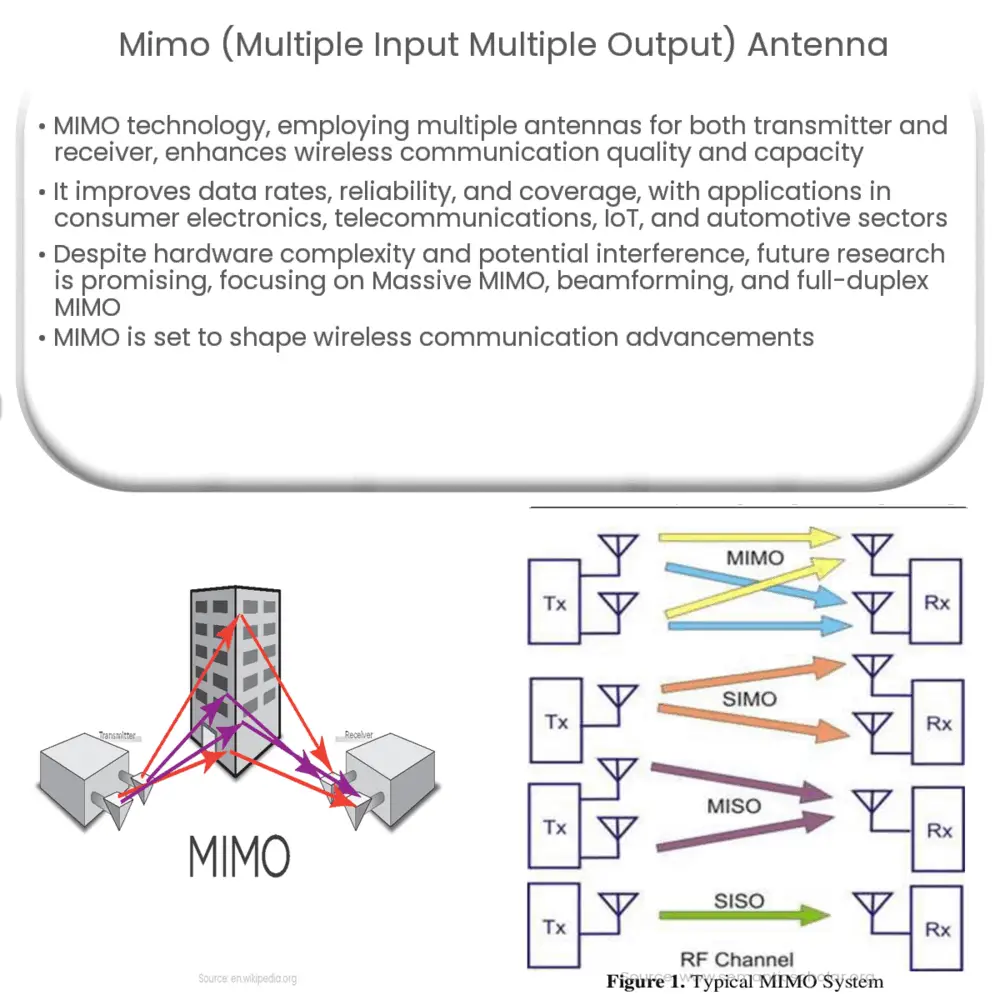MIMO antennas revolutionize wireless communication by increasing data rates, reliability, network capacity, and coverage across various industries.

MIMO (Multiple Input Multiple Output) Antenna: Revolutionizing Wireless Communications
Introduction
As the world becomes increasingly connected, our reliance on wireless communication has grown exponentially. The demand for faster and more reliable data transfer continues to drive innovation in the field. One technology that has revolutionized wireless communications is the MIMO (Multiple Input Multiple Output) antenna. In this article, we will explore the basics of MIMO, its advantages, applications, and future potential.
What is MIMO?
MIMO, or Multiple Input Multiple Output, is a technology that uses multiple antennas at both the transmitter and receiver ends of a wireless communication system. By employing multiple antennas, MIMO systems can improve the quality and capacity of wireless communication without requiring additional bandwidth or increased transmission power. MIMO technology takes advantage of a wireless phenomenon called multipath propagation, where signals bounce off obstacles and arrive at the receiver via multiple paths.
MIMO systems can be broadly classified into three types:
- Single-user MIMO (SU-MIMO)
- Multi-user MIMO (MU-MIMO)
- Massive MIMO
SU-MIMO and MU-MIMO are often employed in consumer devices such as Wi-Fi routers and smartphones, while Massive MIMO is commonly used in large-scale wireless networks such as 5G cellular networks.
Advantages of MIMO
MIMO technology offers several key advantages over traditional single-antenna systems, including:
- Increased data rates: By transmitting multiple data streams simultaneously, MIMO systems can achieve higher data rates compared to single-antenna systems.
- Improved reliability: MIMO systems take advantage of spatial diversity, which allows for multiple paths between the transmitter and receiver. This increases the probability of successful data transmission, even in challenging environments with high levels of interference or physical obstructions.
- Higher capacity: MIMO systems can significantly increase the capacity of a wireless network by allowing multiple users to share the same frequency band simultaneously.
- Enhanced coverage: MIMO technology can provide better coverage in areas with a high density of users or challenging topographies, such as urban environments or hilly terrains.
Applications of MIMO
MIMO technology has found widespread application across various industries and sectors, including:
- Consumer electronics: Wi-Fi routers, smartphones, and other wireless devices now commonly feature MIMO antennas to improve data transfer rates and reliability.
- Telecommunications: MIMO is a key technology in modern cellular networks such as 4G LTE and 5G, enabling faster download speeds, improved coverage, and increased network capacity.
- Internet of Things (IoT): As the number of connected devices continues to grow, MIMO technology plays a crucial role in ensuring reliable and efficient wireless communication among IoT devices.
- Automotive: MIMO antennas are used in vehicle-to-vehicle (V2V) and vehicle-to-infrastructure (V2I) communication systems, enhancing the safety and efficiency of transportation networks.
Challenges and Limitations
While MIMO technology offers numerous benefits, it also faces several challenges and limitations:
- Hardware complexity: MIMO systems require multiple antennas and sophisticated signal processing, which can increase hardware complexity and cost.
- Interference: In some scenarios, MIMO systems can experience increased interference due to the simultaneous transmission of multiple data streams.
- Channel state information: Accurate channel state information (CSI) is essential for MIMO systems to perform optimally. However, obtaining accurate CSI can be challenging, particularly in dynamic environments with rapidly changing channel conditions.
- Energy consumption: The increased hardware complexity of MIMO systems may lead to higher energy consumption, which can be a concern for battery-powered devices.
Future Potential of MIMO
Despite these challenges, the potential of MIMO technology remains vast, with ongoing research and development aimed at overcoming its limitations and expanding its applications. Key areas of focus include:
- Massive MIMO: Massive MIMO is a promising approach that employs a large number of antennas at the base station, significantly improving spectral efficiency and network capacity. This technology is expected to play a vital role in the further development of 5G and future 6G networks.
- Beamforming: Beamforming is a technique that directs the transmission of signals toward specific users, minimizing interference and improving network performance. This is especially important in MU-MIMO systems, where multiple users share the same frequency band.
- Full-duplex MIMO: Full-duplex MIMO technology allows for simultaneous transmission and reception of data on the same frequency band, potentially doubling the capacity of wireless networks. This technology is still in the experimental phase, but its successful implementation could revolutionize wireless communication.
Conclusion
MIMO technology has already made a significant impact on wireless communication, enabling faster data rates, improved reliability, and increased network capacity. As research and development continue to advance MIMO systems, we can expect even greater innovations in the wireless communication landscape. From consumer electronics to large-scale telecommunications networks, the applications of MIMO are vast and will continue to shape the future of wireless connectivity.

